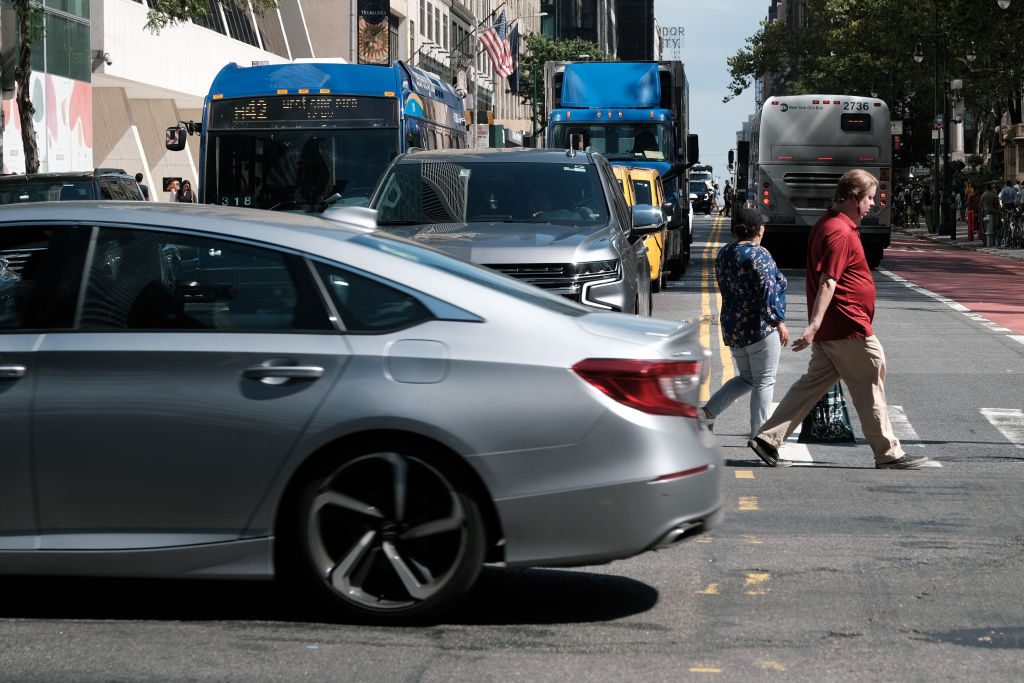
Drivers will pay more to cross into Manhattan south of 60th Street beginning in January, and tolls will escalate in future years. (Photo by Spencer Platt/Getty Images)
New York’s Metropolitan Transportation Authority approved a controversial plan that will add a $9 congestion toll on cars crossing into Manhattan south of 60th Street in a 12-1 vote Monday.
The toll is meant to generate $15 billion in capital funding for the state’s transit authority and ease congestion on New York’s traffic-choked streets, but it has drawn opposition from New Jersey officials who say the city is taxing Garden State residents and displacing traffic and pollution to the west side of the Hudson River.
“This is a hopeful moment. It’s a hopeful moment because it shows that New Yorkers, we collectively can take on and address big challenges that we’re facing,” said MTA CEO Janno Lieber. “It’s even a hopeful moment for drivers because life can and should get a lot better if you have to drive to New York.”
The tolls paid would add to those already paid by drivers entering Manhattan using a bridge or tunnel, though discounts will be available. At present, those tolls can run as high as $15.38 for cars with an E-ZPass, with significantly higher rates for larger vehicles. The Port Authority of New York and New Jersey last week unveiled a proposal to raise those tolls by $1 over four years beginning in January.
The congestion pricing plan, which is also set to take effect in January, is a pared-down version of a proposal New York Gov. Kathy Hochul paused in June because of concerns the original $15 per-crossing rate would enact too steep a toll on residents in the outer boroughs. Hochul revived the proposal, which is opposed by Gov. Phil Murphy, last week.
If you have a better idea of where we can get a billion dollars, we’re all ears.
– MTA board member Neal Zuckerman
The plan, approved by the MTA Monday with a single no vote from Nassau County board member David Mack, calls for tolls to escalate over six years, rising to $12 in 2028 and to $15 beginning in 2031. Starting rates for trucks range between $14.40 and $32.40, depending on size, and would rise to between $24 and $54 by 2031.
Tolls for all vehicles are discounted 75% between 9 p.m. and 5 a.m. on weekdays and between 9 p.m. and 9 a.m. on weekends.
Car drivers making less than $50,000 a year can get their tolls discounted by 50% after their 10th trip in a given month. The plan also allows for a $3 credit for passenger vehicles entering Manhattan through the Lincoln and Holland tunnels during peak hours and a $1.50 credit for those using the Queens-Midtown and Brooklyn-Battery tunnels.
“We will finally begin to deal with congestion and pollution that affects neighborhoods all across the city, including the neighborhoods that I represent here in Manhattan,” Rep. Jerry Nadler (D-N.Y.) told the board.
Most who testified before the board Monday backed the plan, though a few cautioned it would price out some New York residents.
“If you guys go through with this plan, we are going to have less than 8 million people in this city. They cannot afford $9,” said Andy Pollack of Passengers United.
Because the program will phase in, congestion pricing will provide less money for the Metropolitan Transportation Authority’s capital needs in its first years, though board members said Monday they expect state approval of its 2025-2029 capital plan and the funding that comes along with it would cover costs in the interim.
Opposition to congestion pricing has metastasized into numerous lawsuits aiming to block the policy, including one filed by New Jersey that argues federal regulators had not properly considered its environmental impact.
“To those who have sued us to stop us, whether they’re from this state or outside this state, if you have a better idea of where we can get a billion dollars, we’re all ears,” said MTA board member Neal Zuckerman. “We take cash from New Jersey or Connecticut or the federal government as much as we take it within the state.”
GET THE MORNING HEADLINES.

